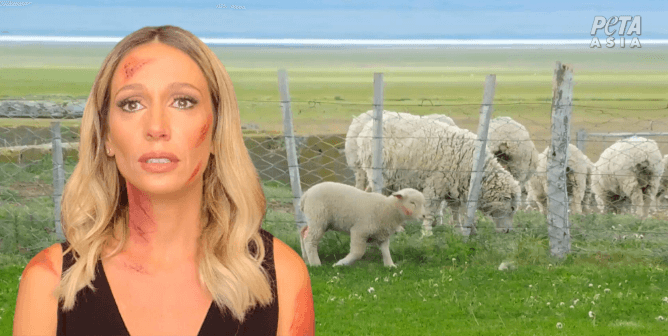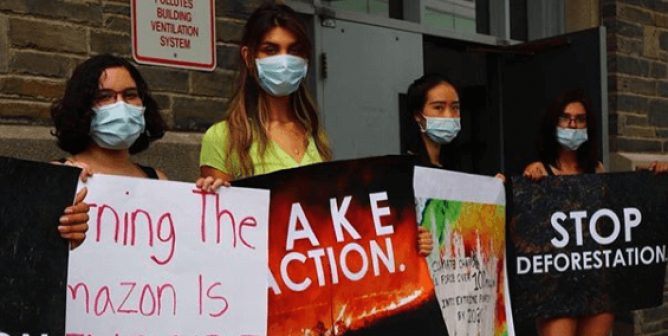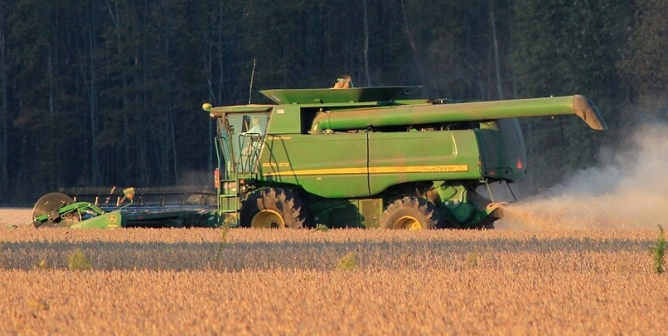Animal Agriculture Is to Blame for Wildfires Around the Globe
Around the world, prolonged heat waves and droughts have extended wildfire seasons. It’s clear that the climate catastrophe is intensifying wildfires, forcing people to evacuate their homes and putting their lives at risk. And the death tolls of these catastrophic events don’t stop at humans. Billions of other animals die in them, and their deaths mostly go unreported.
A leading cause of climate change is animal agriculture, so using animals for food and clothing exacerbates wildfires—and, in many cases, starts them, too. Many ranchers burn land to clear space for raising and feeding animals to be killed for food or skinned for leather, which causes droughts, greenhouse gas emissions, and deforestation, all of which contribute to global warming. So, the deadly fires are often started for animal agriculture and then continue burning because of it.
@officialpeta Don’t be fooled by an industry that profits from cruelty—wool hurts sheep AND the planet.
♬ Sad Somber Piano and Cello – Moko_Music
That’s probably a huge reason why the United Nations has stated that meat consumption must decrease by as much as 90% in order for us to avoid the most catastrophic effects of climate change. Or else we can expect more of the following:
Wildfires in Texas
A series of wildfires have scorched more than 1 million acres in Texas alone as of February 29, 2024, with the Smokehouse Creek fire becoming the largest fire on record in the state, and the second largest in U.S. history. The catastrophic flames have burned a path of destruction, leaving behind the charred remains of scores of homes as well as killing thousands of cattle and some humans. The commissioner of the Texas Department of Agriculture estimated that the number of casualties may reach 10,000, because of those who die in the fires or animals who require euthanasia. Many surviving cattle have sustained severe injuries, such as burnt hooves, udders, and teats.
Wildfires in California
California’s more than 650 wildfires in 2020 burned through at least 1.2 million acres of land—that’s four times the size of all the wildfires that occurred in the state in 2019 combined. These fires claimed the lives of at least seven humans and an unreported and inconceivable number of foxes, rabbits, deer, frogs, mice, coyotes, and other animals who were forced out of their homes and burned alive. Wildfires are nothing new to California, the country’s largest dairy producer, which confined over 1.7 million cows exploited for their milk as of 2019. It’s no secret that clearing land in the name of animal agriculture makes fires more likely to start, and the hot and dry climate on the West Coast sure doesn’t help.
Wildfires in Australia
It’s estimated that over 1 billion animals were killed in bushfires in Australia in late 2019. This is about the same number of farmed animals (like pigs and cows) slaughtered every few days so that humans can eat their flesh. The devastating images of charred koalas moved many caring folks to dig into their own pockets to support relief efforts. Yet many of those people show no compassion for the animals who are killed for their meals. How can they donate to save one species while paying to have another tortured and slaughtered? This major disconnect is exactly what’s causing cows, pigs, chickens, and beloved koalas to suffer.
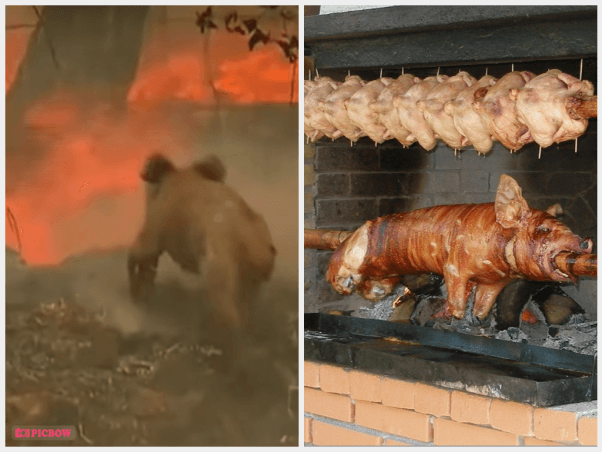
Wildfires in the Brazilian Amazon
About 41,000 fires in the Amazon rainforest in Brazil from January to August 2019 were recorded by scientists, with more than 9,500 new fires in less than one week that summer, the majority clustered inside the Amazon basin. Cattle ranchers are known to start illegal wildfires deliberately in order to make room for more animals, and experts have reason to believe that they started the roaring blazes in Brazil. Three football fields’ worth of the Brazilian Amazon are destroyed every minute, and humans’ appetite for beef is largely to blame. The World Bank reported that cattle ranching has fueled up to 91% of deforestation since 1970.
In 2009, Greenpeace published “Slaughtering the Amazon,” a report concluding that the demand for leather was fueling the destruction of the Amazon in its own right, not as a “byproduct” of beef. It’s all connected: Brazilian beef companies supply leather to leading global fashion brands and retailers. Brazil is filled to the brim with cows, specifically the Nelore breed, originally from India. From 1993 to 2013, the Brazilian herd grew to more than 60 million cows. Brazil exported $1.4 billion in leather products in 2018, and most went to China, Italy, and the U.S., according to the Centre for the Brazilian Tanning Industry.
The cattle sector in the Amazon, the world’s most important forest carbon store, is the single largest driver of global deforestation. Experts say that deforestation is the root cause of the increase in forest fires in Brazil.
Wildfires in Bolivia
In 2019, nearly 2 million acres of Bolivia’s vital Chiquitano dry forests burned down over five days, largely caused by animal agriculture. According to reports, Bolivia’s fires were likely started deliberately in order to clear land for farming but quickly became uncontrollable. Not only do these fires cause massive deforestation, displace countless indigenous peoples, and contribute to the climate catastrophe, they’re also responsible for killing countless animals. According to experts, at least 500 species were put at risk because of Bolivia’s flames. The Chiquitano forest is home to jaguars, giant armadillos, tapirs, and other wildlife.
Wildfires Everywhere
Roughly 260 million acres of U.S. forests have been cleared in order to create cropland to feed animals raised for food. By clearing forest, we eliminate the trees that would have absorbed the rising levels of carbon dioxide and supplied us with oxygen.
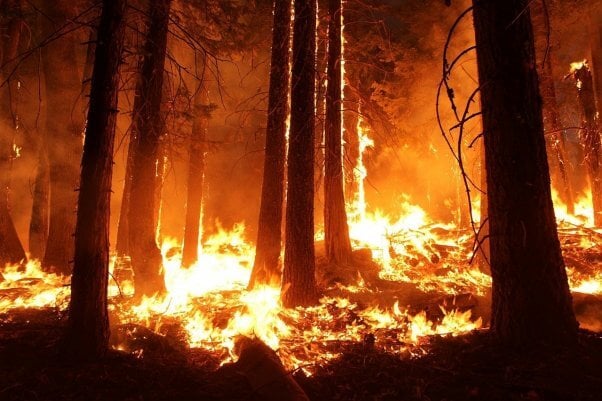
Will Your Animal Companions Be Protected in a Fire?
Deadly wildfires are here to stay. Rising global temperatures lead to increased evaporation, changing precipitation patterns, and more frequent and severe droughts. These conditions create a drier environment, making vegetation more susceptible to ignition and facilitating the rapid spread of fires. If you have an animal companion, what would you do if a wildfire affected your area?
By planning now, you can make sure that all your loved ones can weather any storm. Check out our disaster-preparedness blog post and make a plan.
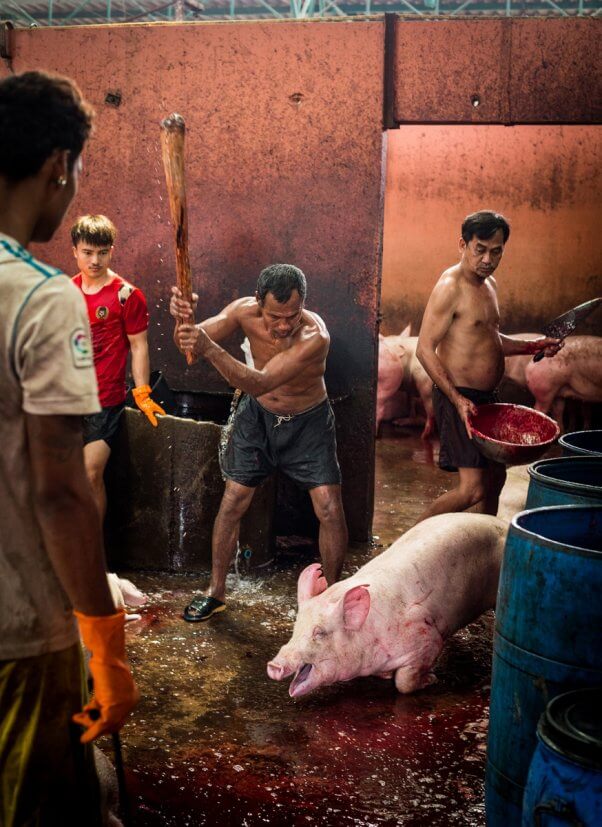
You Can Help Prevent Wildfires
If everyone went vegan, global farmland use could be reduced by more than 75%—an area equivalent to Australia, China, the European Union, and the U.S. combined—and still feed the entire world, all while sparing billions of animals every year horrific suffering and a needless death. An in-depth report from The New York Times found that even the most environmentally harmful way of eating vegan is still better for the planet than the most carbon-saving omnivore diet. Going vegan is the single biggest solution to the destruction that humans are causing to the planet.
Going vegan requires zero government interference or promises from corporations. All you have to do is leave animal-derived items out of your kitchen and closet. So what’ll it be: switching from animal flesh to vegetable protein and from skin to vegan leather—or having a planet that can’t support life? Those are your only two options. Choose wisely!


